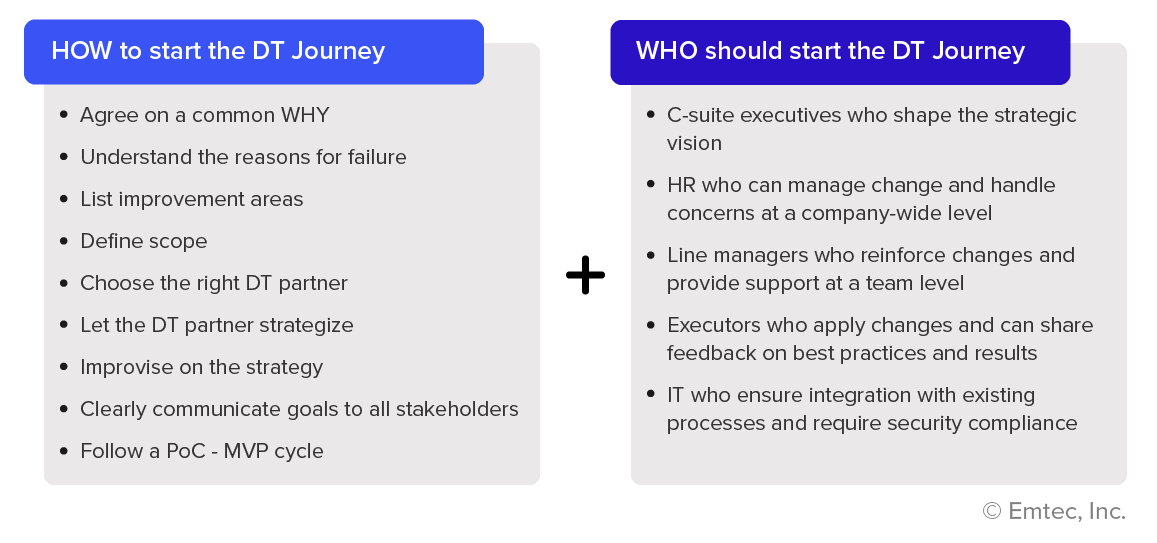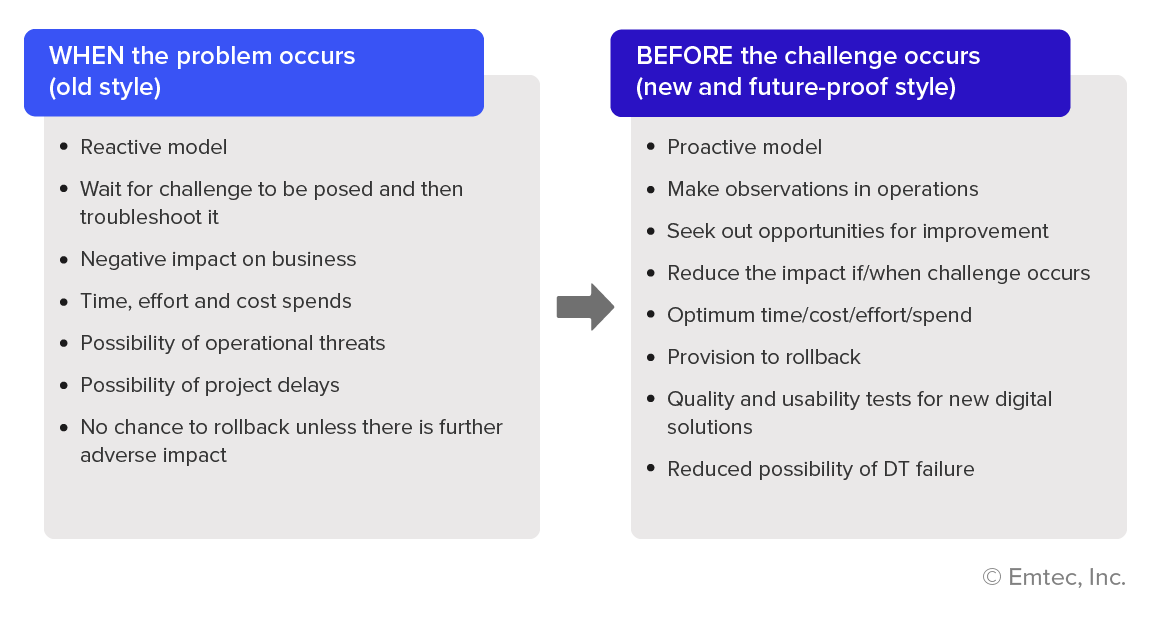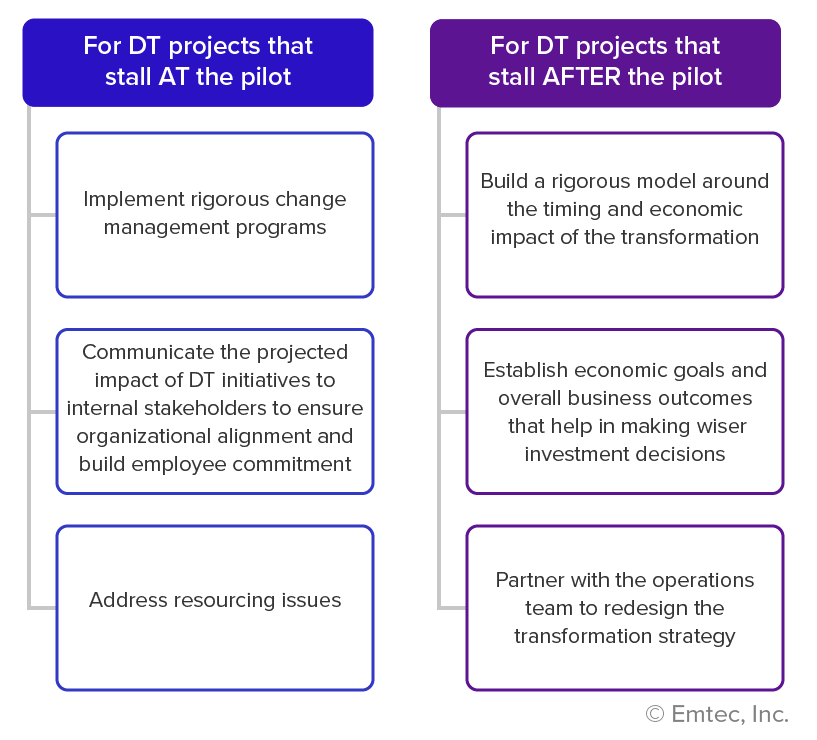COVID-19 has become a catalyst for reviving failed enterprise digital transformation initiatives. Renewed digitalization efforts promise innovation that empowers increased collaboration, drives powerful efficiencies, accelerates growth, and improves the bottom line. For example:
- Logistics organizations are embracing warehouse automation
- Digital-only banks, built on the backbone of technology, are becoming pervasive
- Energy corporations are adopting Data Science and Blockchain
- Services focused firms are becoming increasingly paperless and contactless
There is no doubt that these digital technologies are here to stay. The question is how to harness it effectively. Unfortunately, Digital Transformation (DT) projects have a high rate of failure. Research indicates that around 70% of DT initiatives fail.
As a global provider of innovative digital solutions, our team here at Bridgenext (former Emtec Digital) decided to study the reasons for this alarming trend and provide some helpful tips and strategies to ensure success.
Why do Digital Transformation initiatives fail?
The challenges, potential solutions, and goals for every organization are unique. The reasons for failure in digital transformation vary as well. However, the one reason that will guarantee project failure is miscommunication and misunderstanding of the need vs. solution by stakeholders. In most cases, organizations can control the factors that impede digitalization. Here is a list of primary and secondary causes of Digital Transformation failure –

Lessons learned
Digital transformation is not a shot-in-the-dark endeavor and requires a well-thought out and defined strategy that takes into consideration, among other things, the organization’s –
- Key business goals
- Existing infrastructure investments
- Available resource support
- Current technology stack
Organizations who blindly jump onto the digital bandwagon without fully considering all internal factors will most likely have a DT project that eventually loses direction. Here are a few examples of how companies succumb to pressure to transform digitally.
- Emphasis on quantity over quality
In 2011, a leading electronics enterprise revved up to innovate one of its business units by undergoing digital transformation. They added new devices and infrastructure to elevate their efforts but focused more on quantity than quality. For their short-term goals, they invested billions of dollars in the new tech-savvy business unit and onboarded several new teams. However, a large focus on this business unit affected the quality of other products. Despite their efforts, their stock prices plummeted, and they had to continuously prove their worth to investors.
Lesson
This failure story depicts the consequences of focusing on project size rather than its innovative value. Besides causing delays and technological issues, transforming everything at once can spread resources thin. While it is beneficial for an organization to plan for and invest in long-term goals that provide handsome returns, small teams, small transformational initiatives, and small wins ensure quality results, sustainability and help build a culture open to innovation and change.
- Siloed strategy implementation
In 2014, a leading American automobile manufacturer began a digital transformation initiative with the addition of a new business unit. This unit was situated afar and operated at a glacial speed. The concentration of digital initiatives was restricted only to this unit and the other units were deprived of innovation. The goal of digitally enabled cars was not achieved; instead the results were mismatched deliverables among various business units and negatively affected performance across the organization. Soon, the company lost money, effort, reputation, and their business leader.
Lesson
Siloed efforts are never sustainable. Organizations need to implement robust strategies and embed a culture of innovation. Strategize wisely to experience a positive transformation in efforts and eventual outcomes.
- Lack of vision
In 2012, a consumer goods giant began their journey with a goal to become ‘the most digitally mature company on the planet’. With an already leading position in the market, the new initiatives were meant to take their game to the next level. However, growth challenges, a deteriorating economy and a hollow strategy with no real purpose stalled the organization’s digital efforts. Eventually, the company had to suffer huge losses.
Lesson
This consumer product giant did not consider market demands or fulfill consumer needs and failed to achieve a competitive edge. With DT projects, it is essential to create an inclusive strategy factoring in stakeholder and market scenarios.
Common lessons to be learned from digital transformation failures
- Think about your customer needs (past, present, and future). Build systems and solutions accordingly.
- Build a culture that embraces change. Evolve with time.
- Start with small projects that have a large impact.
- Stay informed of trends but do not follow them blindly. Your needs are unique –your solutions need to be as well.
Learning from failure: Starting the DT journey

Learning from failure: When to start the DT journey

Points to consider before embarking on your digital journey
- Focus on “business” transformation, not just “digital” transformation
- Embed a culture of digitalization within the organizational framework
- Create strategies that drive the overall transformation of the business, not just the adoption of digital technologies
- Focus on key business priorities (revenue growth, customer satisfaction)
- Ensure that the CEO makes key transformation decisions
- The CEO should drive all transformations to ensure a higher success rate
- C-suite onboarding / alignment with DT goals
- Build clarity and commitment across the organization
- Communicate how the implementation of advanced digital technologies will help create benefits to users, newer value propositions, or business models
- Assess the digital IQ
- Have a clear understanding of internal business processes
- Analyze the organizational digital agility
- Identify the right candidates for automation
How to re-ignite failed digital initiatives

The possibilities of digital transformation initiatives are endless. Digital transformation pitfalls can be avoided with the help, expertise and experience of a trusted transformation partner. A dedicated partner can help build a roadmap that identifies your specific business needs, addresses challenges that arise, and further enable you to implement robust digital solutions capable of placing your business on a sustained growth trajectory.
Many technology partners deliver a one-size-fits-all solution that restricts organizational capabilities and wastes resources. At Bridgenext, we focus on adapting to specific client needs and delivering ROI-driven solutions. Through Adaptive Digital Transformation, we empower businesses to –
- Modify the economics of key global markets
- Create newer approaches to unlock superior value to customers
- Engineer a whole new wave of disruptive innovation with sustained growth
Contact us today to (re)build your custom digital roadmap.



